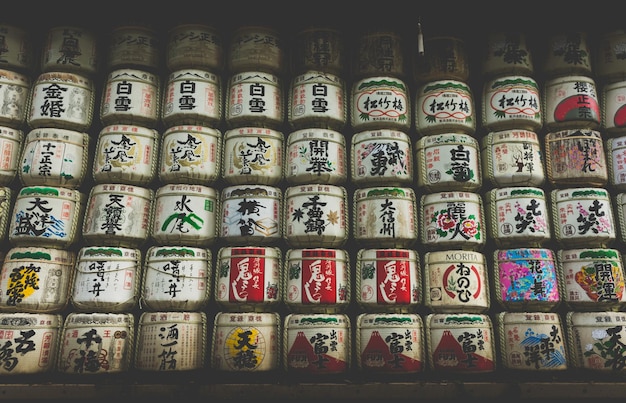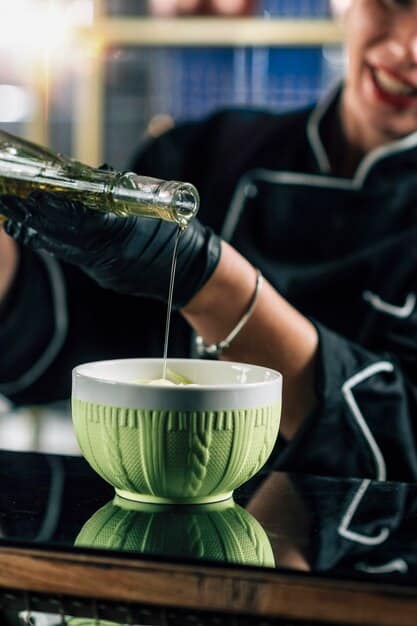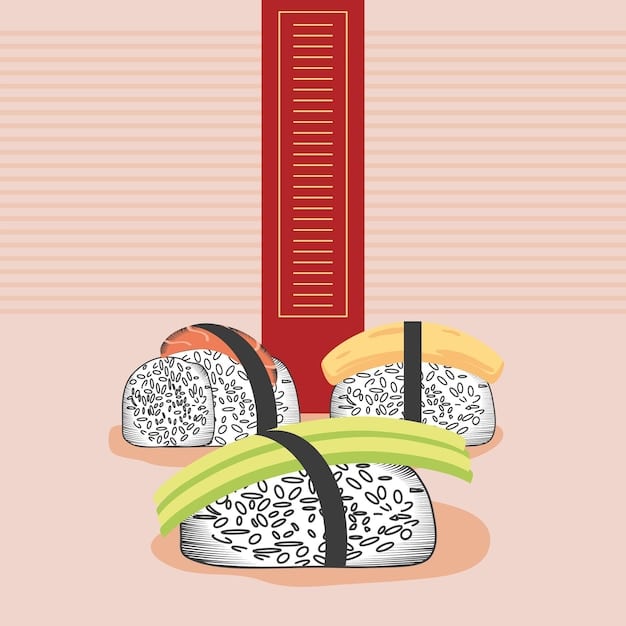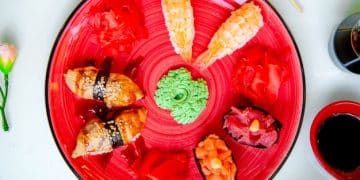Sake Secrets: Decoding Japanese Rice Wine Labels for Perfect Pairing in 2025

Unlocking **sake secrets** involves understanding Japanese rice wine labels, from deciphering key terms like “Junmai” to identifying the Seimaibuai, empowering enthusiasts to curate phenomenal food pairings in 2025.
Embark on a journey to master the art of **sake secrets**: decoding Japanese rice wine labels for the perfect pairing in 2025. This guide will equip you with the knowledge to navigate the complex world of sake, enabling you to choose the ideal brew for every culinary experience.
Understanding the Basics of Sake
Before diving into the intricacies of sake labels, it’s crucial to grasp the foundational concepts. This understanding forms the bedrock for interpreting the information presented on each bottle and making informed decisions.
Let’s explore the key components that define sake and its production process, starting with the essential ingredients.
Key Ingredients in Sake
Sake production, at its core, relies on four primary ingredients:
- Rice: Specially cultivated sake rice, known as *sakamai*, is used due to its larger grain size and higher starch content.
- Water: High-quality water, often sourced from natural springs, is vital for brewing. The water’s mineral composition impacts the sake’s flavor profile.
- Koji: This mold (*Aspergillus oryzae*) converts rice starch into fermentable sugars. Koji rice (*kome-koji*) is crucial for the fermentation process.
- Yeast: Selected yeast strains contribute distinct aromas and flavors to the final product. Different yeast strains yield diverse outcomes.
With a grasp of the ingredients, another crucial element to understand is different sake categories.
Sake Categories
Sake is classified into various categories based on the ingredients used and the rice polishing ratio (Seimaibuai, explained below). Here are some primary types:
- Junmai: Pure rice sake, made only with rice, water, koji, and yeast. No distilled alcohol is added.
- Honjozo: A small amount of distilled alcohol is added to this type, enhancing its flavor and aroma.
- Ginjo: Made with rice polished to 60% or less of its original size. Known for its fruity and floral aromas.
- Daiginjo: Premium sake made with rice polished to 50% or less. Exhibits refined flavors and aromas.

Understanding these basics will empower you to dive deeper into the next sections.
In short, grasping the fundamentals of sake ingredients and categories provides a solid base. This knowledge makes tackling sake secrets, which can be found on labels, far less daunting.
Decoding the Label: Essential Terms
Now that we know the foundational elements behind sake, it’s time to translate the world of Japanese sake labels. Sake labels are dense with information, but understanding the key terms can unlock their secrets.
Let’s break down the lexicon necessary to navigate the world of sake like an expert.
Junmai (純米)
This term indicates that the sake is made from pure rice, water, koji, and yeast, with no added alcohol. Junmai sakes are often richer and more full-bodied than those with added alcohol.
Recognizing “Junmai” is crucial because it distinguishes sake made without additives, which many enthusiasts prefer. It aligns with a philosophy of purity and highlights the natural flavours derived solely from the core ingredients.
Seimaibuai (精米歩合)
**Seimaibuai** refers to the rice polishing ratio, indicating the percentage of the original rice grain remaining after milling. A lower percentage means more of the rice grain has been polished away, resulting in a purer, more refined sake. For example, a Seimaibuai of 50% means 50% of the rice grain remains.
This metric is incredibly important. It provides insights into the quality and potential flavor profile of the sake. Generally, a lower Seimaibuai indicates a more premium sake with cleaner, more delicate characteristics.
Nihonshu-do (日本酒度)
**Nihonshu-do** represents the sake meter value (SMV), indicating the sake’s relative sweetness or dryness. A positive number suggests a drier sake, while a negative number indicates a sweeter sake.
While not always straightforward, understanding sake meter value helps in aligning the sake’s sweetness or dryness with particular foods. It is also worth noting that the perception of dryness can be influenced by many factors, including acidity.
Kanzukuri (寒造り)
**Kanzukuri** translates to “winter brewing,” signifying that the sake was brewed during the cold winter months. This traditional method is favored as the low temperatures help slow down fermentation, resulting in a more complex and balanced sake.
Kanzukuri is highly regarded due to its impact on the sake’s quality. The slower fermentation process allows for the development of nuanced flavors. It helps ensure the suppression of unwanted microbial activity.

By familiarizing yourself with these indispensable terms, you will be well-equipped to decipher sake labels.
To summarise, understanding terms like Junmai, Seimaibuai, Nihonshu-do, and Kanzukuri opens doors to understanding sake. It provides insights into production methods, flavor profiles, and overall quality.
Flavor Profiles and Sake Types
With an arsenal of key words ready to use, the next step is to learn about the flavor profiles associated with specific sake types.
The flavors can range from fruity and floral to earthy and savory. Recognizing these nuances is vital for pairing sake with food effectively.
Fruity and Floral Sakes
These sakes often showcase aromas of apple, pear, banana, or white flowers. They are typically light-bodied and refreshing, making them ideal for sipping on their own or pairing with delicate dishes.
Sakes in this category often fall under the Ginjo or Daiginjo classification. They undergo gentle fermentation processes that preserve their delicate fragrances.
Earthy and Savory Sakes
Characterized by notes of mushroom, nuts, or soy sauce, these sakes tend to be more full-bodied and complex. They pair well with richer, more savory dishes, such as grilled meats or aged cheeses.
These sakes derive their unique traits from traditional brewing techniques. They sometimes have aging processes that can impart unique flavors.
Sweet Sakes
Sweet sakes offer tastes of honey, caramel, or ripe fruit. They make an excellent match for desserts or can be enjoyed as an after-dinner drink.
- Kijoshu: a unique type of sake where sake is used in place of water during the final stages of brewing, resulting in a lusciously sweet profile.
- Mirin: a sweet rice wine that’s sometimes similar to sake, and used often for cooking.
- Amazake: traditional sweet, low- or non-alcoholic Japanese drink made from fermented rice.
When searching for food pairings for sweet sake remember to think of ingredients that balance and harmonize with the sweetness.
Understanding the flavor profiles of different sakes enables you to choose one that complements the dish.
In essence, grasping the flavor profiles of sakes, be they fruity, earthy or sweet, helps unlock a richer, more customized culinary experience.
Sake Serving Temperatures
Temperature dramatically impacts the taste and aroma of sake; understanding how varying serving temperatures change sake is crucial for enjoying the wine in the way the maker intended.
While some sakes are best served chilled, others blossom when warmed. Discovering the optimal temperature for each type of sake is paramount for savoring its nuances.
Chilled Sake (5-15°C)
Chilling sake can accentuate its refreshing qualities and enhance its delicate aromas. This temperature range is ideal for Ginjo and Daiginjo sakes, as it helps preserve their fruity and floral notes.
Serving sake chilled allows for a crisp, clean taste that enhances the sake’s subtle notes without muting its complexity. Cooling sake will also decrease the intensity of alcohol and sweetness.
Room Temperature Sake (20-25°C)
Some sakes, particularly those with more pronounced umami flavors, are enjoyable at room temperature. This allows their complexity to shine through.
- It can be an excellent choice for sakes with subtle earthiness or savory flavors, as it doesn’t mute important aromatic notes.
- Room temperature serving can also be a good choice when tasting or assessing sake.
Serving sake at room temperature is a valid option.
Warm Sake (40-55°C)
Warming sake can amplify its savory and umami components, making it smoother and more mellow. This is best for Junmai and Honjozo sakes but is not recommended for Ginjo or Daiginjo types because the temperature can cause desired delicate flavors to dissipate.
- When warming sake, it’s important to avoid overheating, as it can diminish the delicate aromas.
- Use a water bath (such as a *yuzamashi*) to gently warm the sake rather than microwaving, which can cause uneven heating.
Selecting the correct serving temperature unlocks the full range of flavors inherent in each sake type.
Adjusting the temperature allows for precise control over the sensory experience, customizing it to suit the sake.
Pairing Sake with Food: A Guide for 2025
Now that we are familiar with the essential sake parameters, we can progress to food pairing. Pairing sake with food is an art that enhances both the drink and the meal.
Sake’s versatility allows it to complement a wide range of cuisines and dishes, bringing new levels of complexity to your dining encounters.
Pairing Sake with Seafood
The crisp acidity and umami notes in sake make it an ideal partner for various seafood dishes. From sushi and sashimi to grilled fish and shellfish, sake can enhance the flavors of the sea.
- Junmai Daiginjo: This exquisite sake, celebrated for its refined, balanced flavors and delicate aromatics, serves as an exceptional accompaniment to the subtle, nuanced flavors of high-grade sashimi.
- Honjozo: The heightened umami characteristics of Honjozo harmonize exquisitely with cooked seafood dishes, producing a symphony of flavors on the palate.
When pairing sake with seafood, the interplay of flavors creates balance and elevates the entire dining experience.
Pairing Sake with Meat
Sake’s versatility extends to meat dishes, providing a nuanced alternative to traditional wine pairings. Depending on the cut of meat and preparation style, different sake types can create harmonious combinations.
- Junmai: A richer, fuller-bodied style, Junmai features an enhanced presence of umami and acidity that cuts through the fat in the cut of meat.
- Koshu (aged sake): Its intricate flavor profile and earthy notes make it a surprising contender for the richness of the meat.
Pairing sake with meat showcases sake’s adaptability. The pairings bring depth to the palate.
Pairing Sake with Cheese
Experimenting with sake and cheese pairings can lead to delightful discoveries, as the umami-richness of sake interacts with the diverse flavors and textures of cheese.
This pairing allows for a harmonious blend of umami notes, complementing the creamy flavors, as well as the salt and rich textures of many cheeses.
- Cream cheese: Pair with fruity sakes such as Ginjo.
- Hard cheese: Pair with aged sake.
By exploring these pairings, you’ll be able to enhance both the sake and the cuisine.
In conclusion, mastering sake and food pairings allows for endless exploration. These pairings open up new gastronomic horizons.
Trends and Innovations in Sake for 2025
New innovations continue to reshape the world of sake. You can further refine your sake education by identifying the recent trends.
From sustainable practices to innovative brewing techniques, 2025 promises exciting developments in the realm of sake.
Sustainable Sake Production
As environmental awareness grows, sustainable practices are becoming increasingly important in sake production. Breweries are adopting eco-friendly methods to minimize their impact on the environment, with organic rice farming and water conservation leading the way.
Selecting sake from breweries committed to sustainability also contributes to the longevity of sake traditions. It promotes environmental stewardship.
- Organic rice farming practices can involve reducing the use of chemical fertilizers and pesticides and focusing on natural methods such as crop rotation and composting.
- Energy efficiency can be achieved through many strategies, such as using renewable energy sources like solar power or investing in energy-efficient equipment.
Keep an eye out for sake brands that prioritize sustainability.
Regionality and Terroir
As with wine, the concept of terroir is gaining recognition in the sake world. The idea that the environment in which the rice is grown imparts unique characteristics to the final product is becoming more widely appreciated.
Understanding the regional nuances enhances the appreciation of nuances within the world of sake.
Emerging Sake Styles
Brewers are experimenting with new techniques and ingredients, leading to the emergence of novel sake styles that push the boundaries of tradition. These can offer unique flavors and experiences.
- Sparkling sake: A light-bodied, fizzy sake that is perfect on its own or as part of a cocktail.
- Infused sake: From yuzu to ume, brewers are experimenting with infusions.
These new styles create an exciting space for innovation and exploration.
Keeping pace with the evolving world of sake allows you to discover the next level of culinary insights.
In brief, staying informed about these innovations and trends enhances curiosity and provides the opportunity to broaden your sake horizons.
| Key Concept | Brief Description |
|---|---|
| 🍶 Junmai | Pure rice sake with no added alcohol, offering richer flavors. |
| 🌾 Seimaibuai | Rice polishing ratio, indicating sake purity—lower % means higher purity. |
| 🌡️ Serving Temp | Impacts flavor—chilled for delicate types, warm for savory sakes. |
| 🍽️ Food Pairing | Sake pairs well with seafood, meat, & cheese, enriching flavors. |
FAQ
▼
“Junmai” indicates the sake is made purely from rice, water, koji, and yeast without any added alcohol. It signifies purity, and often richer, full-bodied flavor.
▼
Seimaibuai indicates the rice polishing ratio. A lower percentage means more rice has been polished away, resulting in a purer, more refined sake. It hints at the sake’s quality and potential flavour profile.
▼
Serving temperature greatly changes the flavor. Chilling can accentuate refreshing qualities, while warming amplifies savory notes. Different temperatures suit different sake types.
▼
Consider sake’s flavor profile. Fruity, floral pairs well with light dishes like sushi; earthy, savory types complement richer dishes like grilled meats; sweet sakes suit desserts.
▼
Emerging trends include sustainable production, a focus on regionality/terroir, and new sake styles like sparkling and infused sakes. These trends broaden sake’s appeal.
Conclusion
Becoming adept at understanding sake labels unlocks a gateway to enriching your culinary journey. By deciphering the key terms and delving into the nuances of flavor profiles, serving temperatures, and recent trends, you can confidently select the perfect sake to elevate any dining occasion.





